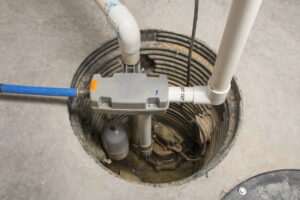 Most people connect springtime with good feelings: warmer weather and blooming plants. But spring has some downsides as well, such as allergies and all that spring cleaning. One concern during spring is potential flooding. Spring can bring with it intense storms, and snowmelt can also lead to flood conditions.
Most people connect springtime with good feelings: warmer weather and blooming plants. But spring has some downsides as well, such as allergies and all that spring cleaning. One concern during spring is potential flooding. Spring can bring with it intense storms, and snowmelt can also lead to flood conditions.
If your home has had trouble with flooding in the basement or crawl space before, then you probably have a sump pump installed to help out. (If you dont, it’s definitely time to get one!) Before the spring weather arrives and brings the threat of flooding with it, we recommend you do several checks on your sump pump to see that it’s ready to do its job if it needs to. You hope it won’t need to, but a preventive device isn’t much good if it won’t actually work when it’s required.
We’ll go over what you can do to check on your sump pump.
Sump Pump Maintenance You Can Handle Yourself
First, make sure your sump pump has power. Homeowners sometimes disconnect the sump pump during the winter. There should be two plugs for your sump pump: one for the motor in the pump and the other for the float switch. Unplug both of them, then plug back in the pump motor one only. This should cause the sump pump to automatically turn on. If it doesn’t, you’ve already found out one serious issue with the pump: something is wrong with the motor. You’ll need to have repair technicians investigate and see if it can be repaired.
Next, perform a water test with the sump itself. Before you pour any water into the sump, look around the sump to see if there’s any debris in it and clean it out. Debris might get drawn into the intakes of the pump and jam it. When the sump is clean, pour a bucket of water slowly into it The pump should activate before the water reaches the top of the pit, and will probably start much earlier than that. When the pump turns on, stop pouring the water and watch to see if the pump successfully removes the water from the sump and shuts itself off.
If the pump doesn’t activate, there may be an issue with the switch, although it could also be a failed motor. If you did the test with the plugs already and the motor did turn on, you’ll have narrowed down the problem to the switch. This is an easy repair for our technicians to do, and we probably won’t need to replace the full pump. Understanding your sump pump and its components can help you identify potential issues early.
Some sump pumps don’t allow you to pour water into the sump. For these sump pumps, you can manually lift the float to see if it causes the pump to activate. Don’t let the pump run for more than a few seconds if there’s no water in the sump, as this can damage it.
If you need assistance with your sump pump or any other part of your plumbing in Buford, GA, we’re the right team to turn to. Regular plumbing maintenance can help ensure your home is ready for spring storms. For more tips on protecting your home’s plumbing, check out our guide on common plumbing issues and how to avoid them.
At Snellville Heating, Air and Plumbing, Your Comfort Is OUR Business. Call us today for sump pump maintenance, repair, or replacement.



